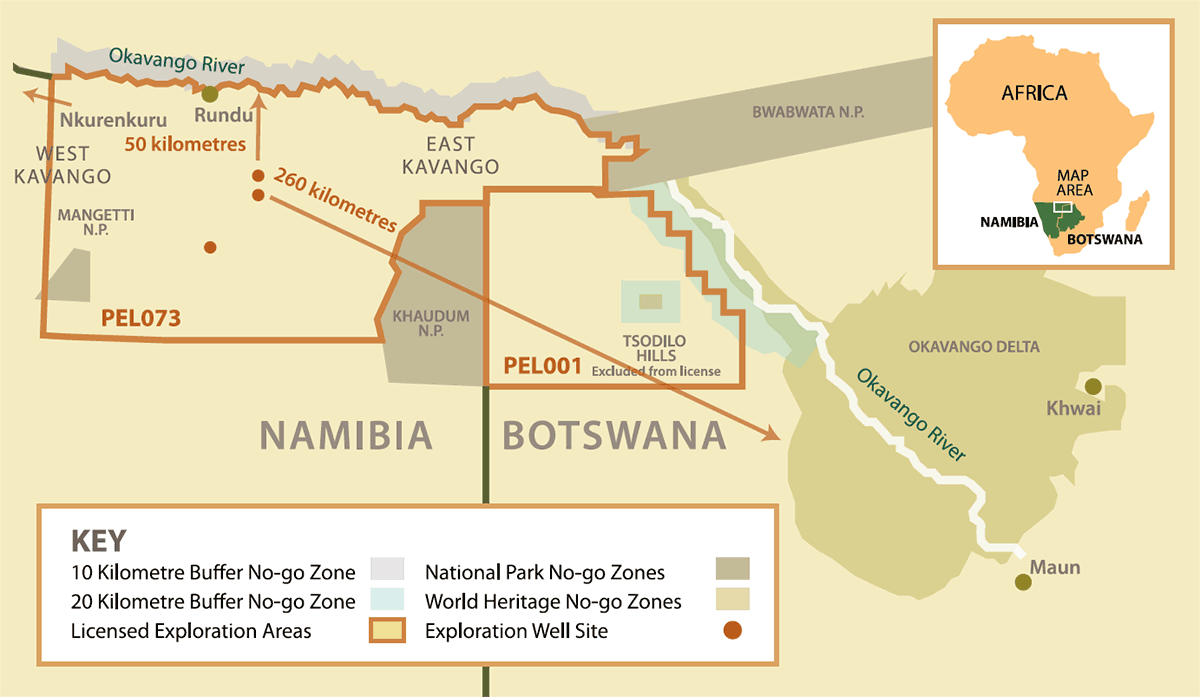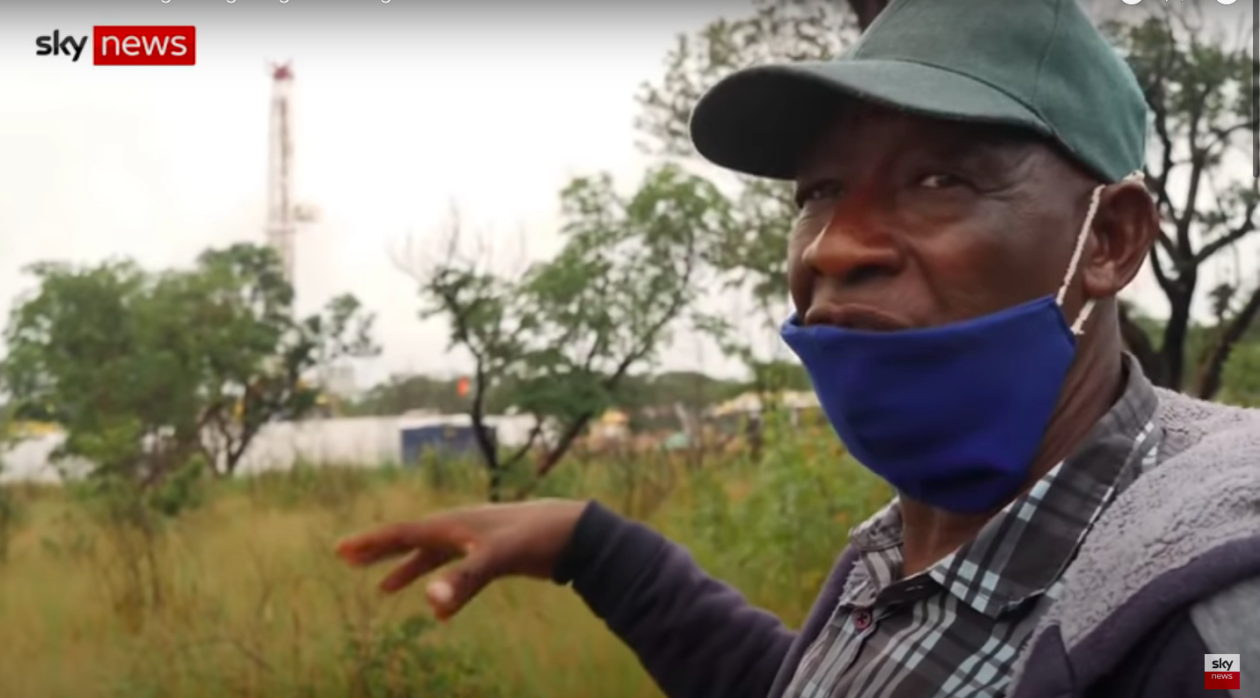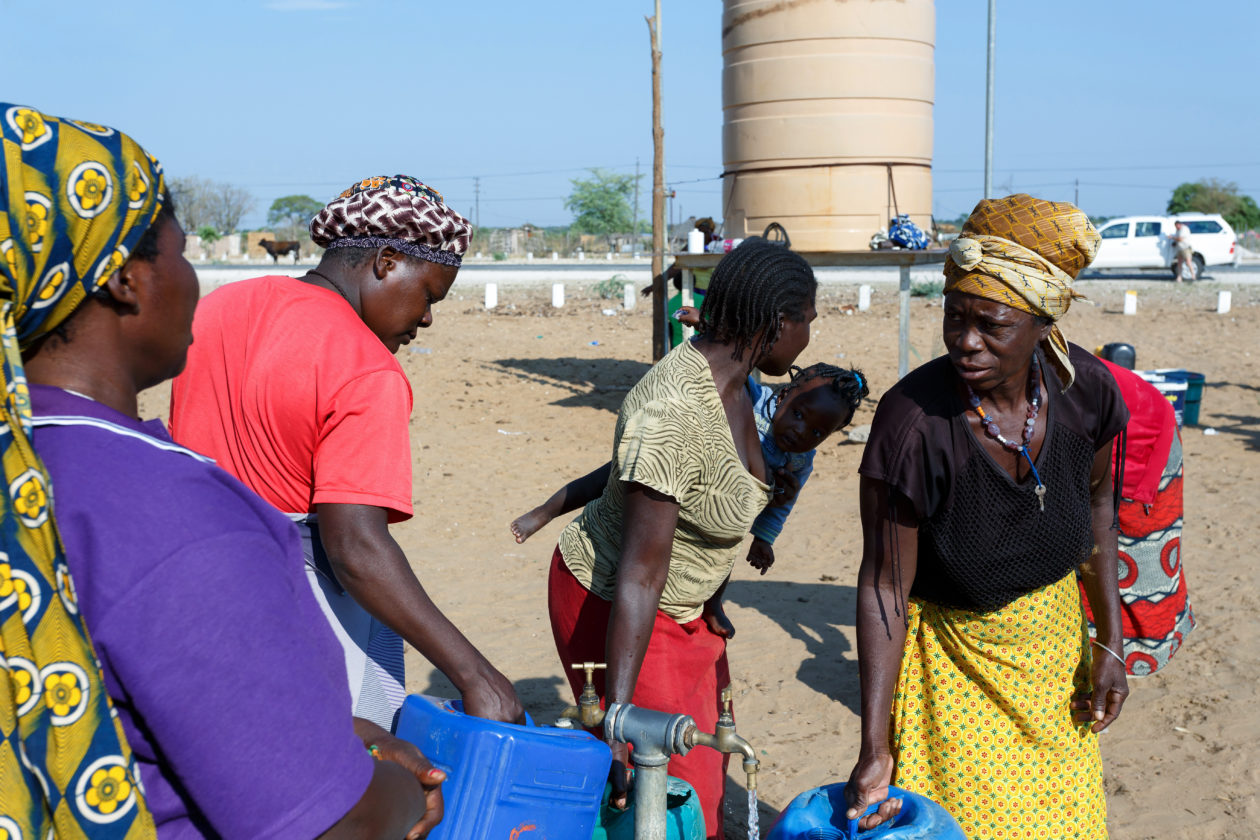BY HEATHER RICHARDSON
A Canadian company is drilling exploratory wells in Namibia for what could be a major oil and gas find. Local residents and conservationists fear the project could use up scarce water supplies and cause widespread ecological disruption downstream in the world-renowned Okavango Delta.
The first Andreas Mawano Limbundi and his family knew of oil exploration in their village in northeast Namibia was as they watched a drilling site being set up about 200 meters from their homestead late last year. Their village — 90 minutes along a potholed dirt road from the town of Rundu on the Namibia-Angola border — was peaceful, with the sounds of birdsong and the wind rustling the tree leaves. Since January 2021, however, that quiet has been shattered by 24-hour drilling. The family has no idea if they will have to leave their home and, if so, whether they will be compensated. They’re also angry that they were not consulted, and skeptical that they will benefit from permanent jobs despite having to live with the test well on their doorstep.
The rig belongs to ReconAfrica, an oil and gas company headquartered in Canada, currently drilling three test wells in the sedimentary Kavango Basin of Namibia. The company has a of 9,800 square miles, plus an adjacent area in neighboring Botswana — 13,250 square miles in total. According to a 2019 obtained by National Geographic, the company’s goal is to drill hundreds of wells under a 25-year production license. Geochemist and ReconAfrica shareholder Daniel Jarvie estimated the basin has the potential to produce as much as , which would make it one of the biggest global oil finds in recent years.
Many residents worry they have been left in the dark and will not gain financially from the oil play.
But ReconAfrica’s plans are touching off mounting questions and opposition. The regions of Kavango East and Kavango West are home to 200,000 people — including the indigenous San — making a living from farming, fishing, and tourism. A network of rigs, pipelines, and roads would sprawl across an environmentally sensitive, semi-arid region that is home to Africa’s largest remaining population of savanna elephants as well as numerous threatened or endangered wildlife species. In addition, the drilling — which may involve hydraulic fracturing, or fracking — also would encompass or border national parks and wildlife conservancies, and could threaten waterways that local communities rely on and that eventually flow into the renowned Okavango Delta, a UNESCO World Heritage Site.
Although many of the inhabitants of the region say they do not necessarily oppose oil drilling, they are concerned that they have largely been left in the dark and will not gain financially from the oil play. Despite the scale of the project, the development is shrouded in a cloak of ambiguity. Many Namibians, including environmentalists and even some in government, were surprised when ReconAfrica shipped an exploratory drilling rig to Namibia in late 2020. Though some local traditional leaders say they were consulted, that information often did not filter down to other community leaders or into many Kavango communities.
“They felt that they were not involved, they were hearing over the radio, over social media, in the media about development on their lands,” said Maxi Pia Louis, director of the Namibian Association of Community-Based Natural Resource Management Support Organizations (NACSO), which has been working with Kavango communities seeking guidance on how to ensure they will benefit from the proposed oil drilling. The Kavango is the poorest region of Namibia, with the unemployment rate reaching nearly 50 percent in Kavango East.
The Kavango Basin, which spans northeastern Namibia and northwestern Botswana, is part of the Kalahari Desert. In an otherwise dry environment, the Okavango River (known in Namibia as the Kavango) is a lifeline, flowing from the highlands of Angola, through northern Namibia, and emptying out into the Okavango Delta, in northwest Botswana. ReconAfrica’s license area is home to the Kavango people – five tribal groups who mostly make their living fishing, cattle herding, and farming pearl millet, maize, and sorghum. Alongside agriculture, tourism — including hunting — is one of the main industries, and locals are worried that extensive oil drilling could drive away wildlife — and visitors.

ReconAfrica's license for oil development covers a 13,250-square-mile area in Namibia and Botswana.
The drilling area is also the homeland of the San — otherwise known as Bushmen — a group of many tribes who have historically been victims of genocide and who lost most of their land during the colonial era. Critics of the ReconAfrica development, including , have declared that the exploration “violates San rights under the UN Declaration on the Rights of Indigenous Peoples.”
“The process has not been an open one, with Namibians waking up to [an oil] venture that has already been signed and settled,” the Bishop of Namibia, Reverend Luke Pato, said in a . “There are many questions to be answered.”
South African San youth leader, Craige Q7 Beckett, is worried that San people in remote parts of Namibia and Botswana wouldn’t hear about the oil development until it is too late. With six other San leaders, Beckett more than 300 miles in February from the South African town of Knysna to Cape Town, to present the Namibian diplomatic mission with a opposing drilling in the Kavango Basin. He’ll soon begin the second stage of his walk, heading into Namibia and Botswana to speak with San communities and assess how the development might affect them.
Driving north from the Namibian capital of Windhoek to the Kavango East capital of Rundu, the scenery shifts from rolling hills — green with the heavy, much-needed recent rains in early 2021 — into dusty plains. Potholes appear along the edges of the tarmac. Donkey carts trundle down the side of the road, along with cows and goats driven by herders. Hawkers hold giant wild mushrooms — omajowa, a seasonal delicacy — aloft to passing vehicles.
Beyond short-term opportunities, the residents of Kavango worry about the state in which ReconAfrica will leave the region. The 2019 environmental impact assessment (EIA) commissioned by ReconAfrica was for glossing over potential ecological problems. Experts cited, among other things, the lack of specialist reports pertaining to flora and fauna — for example, the impact of oil drilling on the plants that San communities use as medicine.
Oil development would likely involve building hundreds of wells, pipelines, and pumping stations.
After the exploration stage, the development would likely involve building hundreds of wells, pipelines, and pumping stations, all linked by access roads. Such industrialization would inevitably result in habitat fragmentation, affecting creatures large and small that will face road mortality and disruption of hunting territories and migration routes. Critics say the EIA also did not sufficiently address the impact on the Okavango region’s 18,000 elephants; maintaining migration corridors for the elephants is crucial to both their safety and that of villagers. The Kavango region also is home to endangered wild dogs, which require large areas in which to hunt, and cheetahs, which are highly vulnerable to habitat loss and fragmentation.
“ReconAfrica refuses to talk about the bigger picture – what the landscape would look like in the event of an oil find,” Chris Brown, CEO of the Namibian Chamber of Environment — an industry-sponsored organization that works with environmental groups — said in an email. “They focus just on the immediate step. The public wants to know what the likely consequences would be of an oil find and the impacts to the Kavango regions and to the Okavango Basin. ReconAfrica refuses to discuss this.”
A key concern is the impact on the region’s water supplies. Indeed, one of the first test wells was drilled close to the Omatako River, which is linked to the Kavango River and is about 150 miles from the Okavango Delta. A major question is whether ReconAfrica plans to frack for oil and gas, which has a history in the United States — where it is most widely used — of contaminating water and causing health issues. Previously, ReconAfrica CEO Scot Evans and the company have discussed unconventional drilling opportunities — a term often used to refer to fracking — in the Kavango. But the Namibian government has said that , and ReconAfrica has since scrubbed any “unconventional” mentions from its literature.
Given that water from the region flows into the Okavango delta, “any pollution would be harmful” to the Okavango Basin ecosystem as well as Kavango communities, says Brown.
ReconAfrica has compared the geological conditions in the Kavango to the — an area where fracking has begun for natural gas — and the company seems confident it has found a major petroleum play. Recon Africa has a 90 percent stake in the Kavango development, the first of its kind in Namibia, while the Namibian government holds 10 percent.

Andreas Mawano Limbundi shows Sky News how close ReconAfrica's test oil well is to his homestead. SCREENSHOT VIA
Geologist Jan Arkert of Africa Exposed Consulting Engineering Geologists — who opposes the development of oil and gas in the Karoo — says he is certain ReconAfrica will have to frack at some point. “To really evaluate the size [of the reserve], they are going to have to resort to some form of stimulation, which is fracking,” he said in an interview.
Fracking requires an enormous amount of water — anywhere from 1.5 million gallons to 16 million gallons per well — and Namibia is a water-scarce country. Arkert says the Kavango’s aquifers are not extensive enough for this amount of water and that they’re relied on by communities for their own consumption and agriculture. That means, he said, that the only viable source would be the Kavango River, which runs around the border of ReconAfrica’s license area.
If fracking occurs, all that water will need to be transported, often long distances by truck, to drilling wells. After it’s been used for hydraulic fracturing, water, mixed with the chemicals, is often returned to the surface as hazardous waste. Contaminated water could affect communities, livestock, and wildlife. Already, said that water wells may have been contaminated due to a lack of lining in the drilling wells.
In the United States, hazardous waste from drilling operations is often disposed of with deep-well injection technology, where the waste is buried deep in the ground. But this has triggered earthquakes, even in seismically stable places, such as Oklahoma. The Okavango Delta is seismically active, with a series of fault lines.
The lack of job opportunities in the region is one of ReconAfrica’s key arguments for its project.
“Who knows what’s going to happen to the Okavango Delta? Will it change the flow direction?” Arkert asks. “I certainly can’t answer that. But are we prepared to take that risk?”
Perhaps of most immediate concern to local communities is ReconAfrica’s opacity. Max Muyemburuko is the chairperson of the Kavango East and West Regional Conservancy and Community Forestry Association. Although ReconAfrica’s license area , the first Muyemburuko heard of the development was last November. He said recent meetings have still not revealed anything about potential negative impacts and what ReconAfrica plans to do about them. (ReconAfrica did not responded to Yale Environment 360’s requests for comment, though a spokeswoman told National Geographic that “ReconAfrica will ensure that there is no environmental impact from these wells.”)
Hamweyi village headman Mangundu Reinhardt — who also said he was not consulted or informed about ReconAfrica’s plans — said that he’d heard few complaints because most people simply had no idea what was happening. But Muyemburuko said at least one community member he met was enthusiastic about jobs that might be created and the prospect of greater prosperity in the Kavango region. Some hope ReconAfrica may fix the long dirt road to Kawe, the site of a test drilling well. Currently, the drive is laborious, the road pocked with deep holes, with frequent sections of bone-shaking corrugated ridges. The company has also drilled water wells for the Kawe community.
The lack of job opportunities in the region is one of ReconAfrica’s key arguments for its project. The company said that as of late last year, 44 people were working on at the test drilling site near Kawe village, including 29 Namibians, seven of whom are from the village. Local residents say some women from the area have been hired to work in the kitchen and the other opportunities are one-week contracts for jobs such as digging a vegetable garden.

Women at a public drinking water tank in the Kavango region of Namibia, where water is scarce.
Some local residents say they are concerned that if full-fledged drilling moves forward, most jobs will be taken by foreigners or people from elsewhere in Namibia who have the necessary skills and experience. But in its , ReconAfrica says the development will be an economic boon for the region, and quotes one resident born and raised in Kavango, Taye Reino, attacking environmental opponents as “prophets of doom.”
“Stop with the fear mongering,” Reino is quoted as saying. “This kind of stuff has failed to deliver development to this part of the country.”
Local leaders and residents have not been encouraged by the environmental assessment practitioner who wrote the EIA, Sindila Mwiya of Risk-Based Solutions. have accused him of acting hostilely toward anyone questioning ReconAfrica’s activities. After Muyemburuko emailed Mwiya some questions in January, Mwiya — who is supposed to be unbiased in his role — responded by labeling one question about the removal of trees as “stupidity and nonsense of the highest level” and accusing Muyemburuko of “Eurocentric and colonial thinking” in denying people the chance for jobs and regional development.
Muyemburuko says, however, that he does not oppose ReconAfrica’s plans, per se.
“I’m not against the development,” he said. “But the people, the community closest to the area, they have to benefit from this project.”
Source:
Related to SDG 13: Climate action, SDG 15: Life on land and SDG 7



